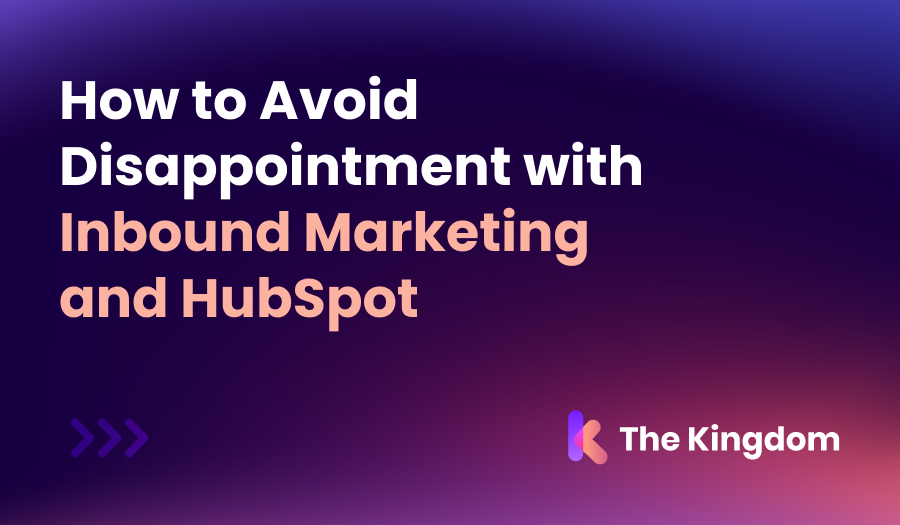
Why does HubSpot and inbound marketing fail? It's a bold question. When analysing any business decision, it's always worth looking at the downside.
So if you are considering using HubSpot, what can go wrong?
Let's consider some of the reasons that cause a failed HubSpot and inbound marketing deployment.
Fail Point: Not Enough Leads
Cause: not enough content.
Not having enough leads, in the experience of The Kingdom Team, is a result of not having enough content. Inbound marketing works best when there is significant amounts of structured content.
Structured content needs to have a purpose. The goal is to engage and convert your prospects into customers. Your content helps the prospect build trust with you and your brand. Educating your prospect is key to converting them to a client.
95% of buyers chose a solution provider that “Provided them with ample content to help navigate through each stage of the buying process” [Source: DemandGen Report]
With more content, it is easier to be found by Google. Think of each time you add a page of content to your website - you are adding another needle in the Google haystack. The more needles in your search haystack, the more chance Google has to find you. As a result, the more leads you get.
You need to have the content so you can be found, and so you can be trusted.
Fail Point: Jumping In and Trying to Sell to Your New Prospects Too Soon
HubSpot will show you the contacts in your portal that are on your website at any given moment in time. But, seeing your prospects engaged does not mean you automatically go and call them.
Prospects are checking out your website, in varying stages of trust, as they travel on their buyer journey. Let them. Have patience.
Over eager sales people can jump in too soon and ruin the party. Calling your prospect while they are still learning about your business is interruptive. This can scare a new prospect away. Scaring them off results in opportunity missed.
It's important that you have an inbound marketing strategy for your website. A clever strategy will divide your website into four sections. An engagement section, Top of Funnel, Middle of Funnel and Bottom of the Funnel.
By knowing which pages fit into which part of the education and trust process, then you can understand exactly where your prospects are on their buyer journey.
With the Professional and Enterprise version of HubSpot, you have lead scoring. Lead scoring creates a score to help you appreciate how much of your content your prospect has consumed.
Lead scoring makes it easier to grade the level of interest prospects have about your business.
Avoid blowing your sales leads by being over zealous and rushing in too early.
Fail Point: Giving Up on Inbound Marketing Too Soon
Inbound marketing success is directly related to the size of your website. Progress is a function of the content you offer and the ability for you to attract, engage and convert your customers. This content takes time to create.
HubSpot is a powerful software tool that makes it easier to create content. But even so, it does take hard work to increase your page count. Particularly if you are focussed on a Growth-Driven Design website building methodology. You can learn more about Growth-Driven Design here.
Realistically it takes 10-15 months to get your inbound content marketing firing. It's all about momentum, though. With inbound marketing, you are building a long-term website asset. Your website is a lead generating machine. This process, once started, is very hard to stop.
It's a different mindset compared to most pay and pray methods of advertising, like Radio, TV and Newspapers.
Giving up early is just like putting a half built engine in a car and complaining the car does not work. It takes time.
Fail Point: Thinking HubSpot is a Magic Wand
HubSpot is not a panacea for bad marketing. It will not fix a business that is not providing enough resources to marketing.
HubSpot is an automated sales and marketing software platform. It is a tool. It is a tool to make the job of sales and marketing more efficient and measurable. Skill is still needed to make it work successfully.
HubSpot gives sales and marketing a boost in productivity. It offers many tools to the user to gain time and brings great ideas to market faster. Marketing people can spend their time dreaming and implementing great solutions, unhindered by technology. Sales team members can spend more time getting deals and less time making tech work for them.
However, HubSpot will not fix poor marketing performance. If you are marketing based on dated assumptions and traditional principles, then not much will change.
If you are not embracing a marketing culture, HubSpot will not save you. If you are short or not dedicating enough resources to marketing success, then HubSpot will not cure your issues.
HubSpot is a fire starter for a marketing and sales renovation in your organisation. It provides you with an organised, innovative platform for productivity. Are you concerned your organisation is underperforming? Deploying HubSpot can be an excellent way to improve your business.
Fail Point: HubSpot Requires Change Management
HubSpot requires professional deployment. If you were to deploy a new accounting system, it's likely there would be hundreds of hours dedicated to training and implementation. A successful implementation of HubSpot requires a similar investment.
It's likely your business will have a broad tolerance for bedding down an accounting system. This is no different. It's important to remember that sales and marketing make the money that accounting counts. Deploying an automated sales and marketing platform like HubSpot requires a similar effort to be successful.
Customers believe that sales reps are 88% knowledgeable on product and only 24% on business expertise. [Source: Corporate Visions]
Like any powerful business tool, it is important to learn and discover the full feature set of the platform. This will take at least a year.
HubSpot is a big program and it will require change to appreciate and understand it's powers. Good news is there are over 18,000 HubSpot customers that have gone before you, so there is lots of support.
Fail Point: You Forget the Why
You need to remember the purpose as to why you have sales and marketing, and what your goals are. If you are deploying HubSpot, chances are you have some key performance indicators you want to achieve.
Businesses take years to build and mature, not days and weeks. By focussing on the "why", you see the big picture and stick to plans with the goal to make them work.
We see failure when people forget the original reason why they deployed inbound marketing and HubSpot. Remember the why. Why did you invest in HubSpot and inbound marketing in the first place?
Fail Point: Lack of Investment in Support Resources
HubSpot provides remarkable training and accreditation programs to empower your employees. The best HubSpot deployments have a deployment team, like The Kingdom working with you. As a Platinum Certified HubSpot Partner, The Kingdom specialises in making your HubSpot investment work for you.
To ensure success, it is critical that you allocate the necessary resources to train your team.
Fail Point: Expecting ROI in Days, Not Years and Months
In the modern day marketing and advertising world, it's very hard to get ROI in short periods of time (days). The digital media landscape is too fragmented, and prospects are too hard to reach with an expensive quick fix. It's pretty much impossible without massive budgets, like that of large enterprises.
There are simply too many channels with audiences spread widely across the Internet. Your inbound marketing investment and HubSpot deployment need time to evolve and work.
The Number One Reason...
So what is the number one reason to be aware of that can cause your HubSpot implementation to go south?
It's your sales team.
HubSpot creates leads, but the biggest problem we see is that salespeople do not convert the leads.
This is by far and away the major reason why deploying HubSpot is perceived to fail.
It's the most common issue. Management wants ROI. HubSpot creates the leads, but a lack of modern day sales skills results in ROI not being achieved. A litany of missed opportunities is left behind.
Inbound selling is a new, more efficient way of generating leads, but it is different. Traditional sales techniques need to be revamped to get with the modern Internet era. Sales teams need to be able to identify the new methods of lead qualification and appropriately act.
This means your organisation needs to invest in sales training, and usually lots of it. Regardless of your software investment, modern business requires a regimented sales training process.
Adding HubSpot to an organisation that is continually improving its sales force ignites momentum.
If the sales team is old-fashioned, then the leads become missed opportunities.
Sales training is critical for your organisation. Regardless of your sales and marketing platforms and procedures, your sales teams need regular professional development.
This is particularly relevant when you consider that the Internet has given all of the power to the consumer. We are in the golden age of consumerism. Salespeople simply must improve their skills to match the advantage the Internet gives consumers.







